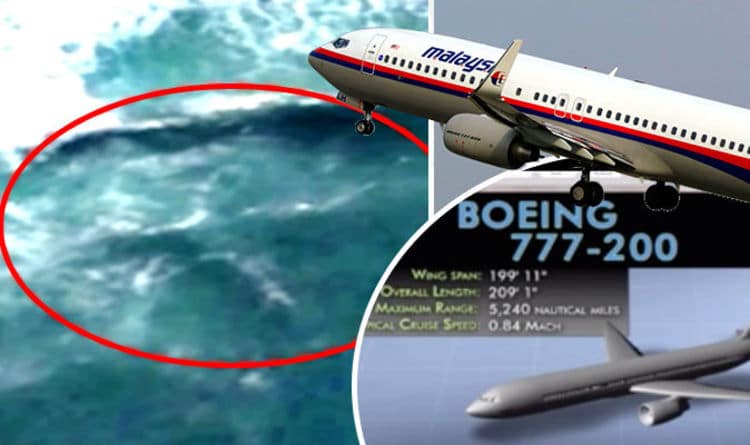On a serene evening, under the sprawling canvas of the night sky, Malaysia Airlines Flight MH370 embarked on what should have been an uneventful journey. Departing from Kuala Lumpur International Airport on March 8, 2014, the flight carried 239 souls—passengers and crew members—all with their own stories, dreams, and aspirations. However, as the clock ticked past midnight, the fate of this Boeing 777-200ER would be sealed in an enigma that continues to baffle the world to this day.
The vanishing of Malaysia Airlines Flight MH370 is a haunting enigma that transcends the realms of ordinary aviation mysteries. It stands as a testament to the boundless complexities of our modern world—a world where advanced technology, vigilant radar, and meticulous air traffic control should render the disappearance of a commercial airliner impossible. Yet, on that ill-fated night, impossibility became reality, leaving an indelible mark on aviation history.
The flight, scheduled for a routine six-hour passage from Kuala Lumpur to Beijing, unfolded with an eerie sense of normalcy. Little did anyone suspect that this voyage, like none other before it, would catapult the aircraft into the annals of inexplicable vanishing acts. The initial moments of the flight were uneventful, the engines thrummed with reassuring precision, and the passengers settled into their seats, unaware of the impending uncertainty.
Approximately 40 minutes after takeoff, the voyage took an ominous turn. In a chilling sequence of events, the aircraft’s transponder—the vital lifeline of communication between air traffic controllers and the airplane—fell silent. The radar screens that had dutifully tracked MH370 suddenly blinked empty, devoid of its familiar blip on the screen. It was as if the airplane had slipped into another dimension, leaving the world bewildered, and air traffic controllers struggling to comprehend the inexplicable void.
In the wake of this sudden and bewildering silence, the aviation world swung into action. The disappearance of Flight MH370 triggered one of the most extensive search and rescue operations in history, drawing upon resources from Malaysia and neighboring nations. The search initially focused on the South China Sea, where the plane had last been tracked, but it soon grew to encompass vast expanses of the Indian Ocean.
Ships, planes, and satellites scoured the waters below, meticulously scanning the surface for any sign of the missing aircraft. The operation was characterized by its scale, complexity, and the unprecedented use of technology to locate a missing plane. Yet, despite the massive search efforts, the wreckage of Flight MH370 remained a ghost, slipping further into the realm of mystery.
As the years passed, the saga of MH370 gave rise to countless theories, ranging from pilot suicide to mechanical failures and even conspiracies involving governments and espionage. The inexplicable nature of the aircraft’s vanishing has fueled speculation and intrigue on a global scale. Yet, amid the theories and conjecture, one stark fact remains—the exact fate of Malaysia Airlines Flight MH370 and the 239 souls on board remains unknown.
In this article, we will delve into the events leading up to the vanishing of Flight MH370, the extensive search efforts that followed, the myriad of unanswered questions that linger, and the impact of this enigmatic disappearance on the aviation industry. Join us on a journey through one of the most profound aviation mysteries of our time—a journey that has left us yearning for answers, closure, and a deeper understanding of the boundless complexities of our modern world.
The Vanishing Act

On a seemingly ordinary night, Malaysia Airlines Flight MH370 departed from Kuala Lumpur International Airport en route to Beijing Capital International Airport. The Boeing 777-200ER, carrying 227 passengers and 12 crew members, was scheduled for a routine six-hour journey. Little did anyone know that this would become one of the most perplexing aviation mysteries in history.
The aircraft took off at 12:41 AM local time, and all seemed normal during the initial stages of the flight. However, approximately 40 minutes after takeoff, the aircraft’s transponder, which communicates crucial information to air traffic control and other aircraft, suddenly ceased transmitting.
The sudden loss of communication and radar contact with MH370 left air traffic controllers in Malaysia bewildered. They tried to establish contact with the flight, but all efforts were met with silence. The aircraft had seemingly vanished from the radar screens without a trace.
The Search Begins
The disappearance of Flight MH370 triggered an immediate and extensive search and rescue operation. Malaysian authorities, along with assistance from neighboring countries and international agencies, initiated a massive effort to locate the missing aircraft.
The initial search focused on the South China Sea, where the aircraft was last seen on radar. As days turned into weeks, the search area expanded to encompass the Indian Ocean. The unprecedented scale of the operation involved ships, planes, satellites, and underwater exploration technology. However, despite the resources poured into the search, the wreckage of Flight MH370 remained elusive.
The Unanswered Questions of Flight MH370
The vanishing of Flight MH370 left the world with a multitude of unanswered questions, fueling theories and speculation. One of the most puzzling aspects of MH370’s disappearance is the abrupt loss of communication and radar contact. The aircraft’s transponder, which is designed to transmit crucial information, was manually disabled, suggesting that someone with knowledge of the plane was involved. Yet, the reasons behind this remain a mystery.
Analysis of available radar data indicated that, after losing contact, MH370 deviated from its intended flight path, making several inexplicable turns. These erratic maneuvers have led to speculation about possible human intervention and intention, but the motives remain unknown.
Further adding to the intrigue is the fact that various communication systems on the aircraft were manually turned off, including the Aircraft Communications Addressing and Reporting System (ACARS). The disabling of these systems raises questions about who had access and why they were deactivated.
Despite extensive search efforts, the wreckage of MH370 eluded discovery for years. It wasn’t until July 2015 that a piece of the aircraft, a flaperon, washed ashore on Reunion Island in the Indian Ocean. This discovery marked the first tangible evidence that the aircraft had indeed crashed in the ocean. Yet, the exact location of the main wreckage and the majority of the passengers’ remains remain unknown.
Theories and Speculations about Flight MH370
The baffling disappearance of Flight MH370 has given rise to numerous theories and speculations, some of which are more credible than others. One of the most discussed theories revolves around the possibility of pilot suicide. Some experts have suggested that the captain or first officer may have intentionally crashed the plane. However, there is limited evidence to support this theory, and it remains highly controversial.
Mechanical failure is a plausible explanation for the disappearance, but it fails to account for the deliberate disabling of communication systems. Nevertheless, some experts believe that a catastrophic event, such as a fire or structural failure, could have incapacitated the crew and led to the plane’s erratic flight path.
The theory of hijacking has been considered, given the deliberate actions taken to disable communication systems. However, no group or individual has claimed responsibility, and no demands were made, making this theory less likely.
Another theory is that the aircraft may have been unlawfully interfered with by a passenger or crew member. This theory is based on the assumption that someone on board had the knowledge and capability to disable critical systems. However, identifying a motive remains a challenge. Some experts believe that technical glitches or malfunctions in the aircraft’s systems may have caused communication failures and erratic flight paths. While this theory is plausible, it does not explain the manual disabling of systems.
The Search for Clues
In the years following the disappearance of MH370, efforts to find the missing aircraft and provide answers to the grieving families continued. This phase of the search involved a comprehensive underwater search in the southern Indian Ocean.
Sophisticated sonar technology, autonomous underwater vehicles, and underwater mapping were employed to scour the ocean floor. The search area was narrowed down based on satellite data and drift analysis of recovered debris. After extensive efforts, multiple pieces of debris were found, offering tangible proof that MH370 had ended its journey in the southern Indian Ocean.
The Impact on Aviation
The mysterious disappearance of Flight MH370 had a profound impact on the aviation industry. It prompted a reevaluation of safety and security procedures, as well as a reassessment of tracking and communication systems.
In response to the disappearance, aviation authorities and industry stakeholders have initiated efforts to enhance real-time tracking of aircraft. This includes the development of more advanced satellite communication systems and the requirement for aircraft to transmit their positions more frequently.
The International Civil Aviation Organization (ICAO) has implemented new regulations to enhance aircraft tracking and communication. Airlines are now required to track their aircraft at least once every 15 minutes during flight, even when flying over remote areas.
The incident also sparked discussions about passenger screening and security protocols. While there is no evidence of terrorism in the MH370 disappearance, the incident prompted a broader dialogue on aviation security.
Nearly a decade has passed since the disappearance of Flight MH370, and many questions remain unanswered. The search for the aircraft has officially concluded, but the families of the victims and the aviation community continue to seek closure and understanding.
The legacy of MH370 serves as a stark reminder of the complexities and mysteries that can arise in the world of aviation. It underscores the need for ongoing vigilance, technological advancement, and international cooperation to prevent similar tragedies in the future.
Final Thoughts On the Unsolved Mystery Of Flight MH370
Nearly a decade has elapsed since Malaysia Airlines Flight MH370 inexplicably vanished into the vastness of the southern Indian Ocean, taking with it 239 lives and leaving behind an enduring enigma. The passage of time, however, has not dimmed the intrigue, nor has it diminished the collective yearning for answers and closure. The conclusion to this mystifying story remains as elusive as the aircraft itself, leaving us with more questions than answers.
Flight MH370’s vanishing act serves as a stark reminder of the enigmatic complexities that occasionally punctuate our modern world. In an age where advanced technology, radar systems, and communication networks are woven into the fabric of aviation, the disappearance of a commercial airliner seems paradoxical, even surreal. Yet, the mysteries of that fateful night persist, defying the logic and reason upon which we rely.
The story of MH370 is not solely a narrative of aviation; it is a reflection of the human condition—a story of families, friends, and loved ones who continue to grapple with the absence of closure. For the families of the 239 souls on board, the unanswered questions represent an enduring source of heartache and longing. Their pain serves as a stark reminder of the very human element at the heart of this perplexing mystery.
The enigma of Flight MH370 has given rise to numerous theories, ranging from plausible explanations rooted in aviation to more speculative and conspiratorial narratives. While these theories provide avenues for exploration, they also underscore the profound gaps in our understanding of what transpired on that ill-fated night.
The search for MH370, one of the most extensive and technologically advanced in history, ultimately yielded tangible evidence in the form of debris scattered across remote shores. However, the discovery of these fragments merely offered glimpses into the tragedy, rather than the comprehensive answers that the world yearned for. The main wreckage and the majority of the passengers’ remains remain hidden beneath the depths of the Indian Ocean, an unyielding testament to the enigma that continues to endure.
In the aftermath of MH370’s disappearance, the aviation industry transformed. Regulations were revised, communication systems were improved, and tracking mechanisms were enhanced. The lessons learned from this tragedy, while born out of sorrow and mystery, have paved the way for a safer and more vigilant aviation landscape.
As we reflect on the enduring enigma of Malaysia Airlines Flight MH370, we are reminded of the limits of human knowledge and the boundless nature of the world in which we live. The story of MH370 is a testament to the inexplicable complexities that occasionally punctuate our lives, and it underscores the importance of resilience, determination, and international cooperation in the face of the unknown.
While the conclusion to this story remains tantalizingly out of reach, our pursuit of truth and closure persists. The mystery of Flight MH370 endures as an unsolved puzzle, a haunting reminder of the enduring enigmas that continue to shape our world. It stands as an enduring testament to the collective human desire for understanding, closure, and the unwavering quest for truth in the face of the unknown.

